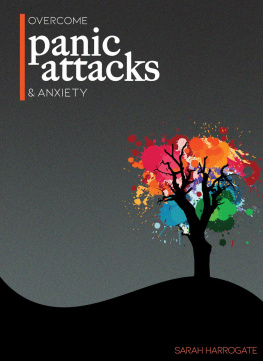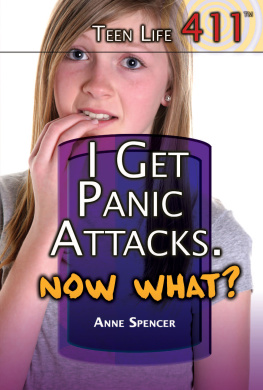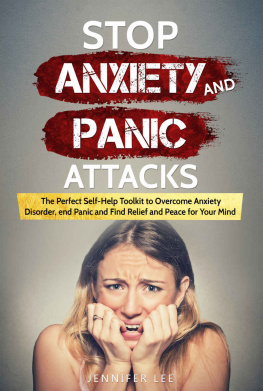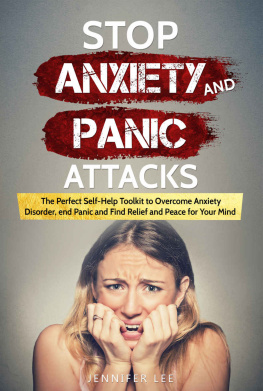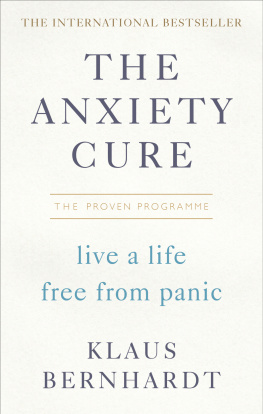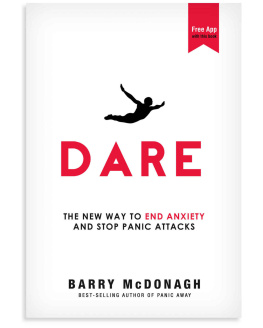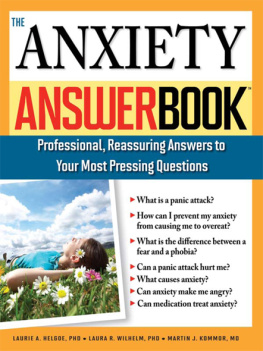Anxiety and Panic Attacks
Recent Titles in
Q&A Health Guides
Self-Injury: Your Questions Answered
Romeo Vitelli
Living Green: Your Questions Answered
Amy Hackney Blackwell
Sexually Transmitted Diseases: Your Questions Answered
Paul Quinn
Mindfulness and Meditation: Your Questions Answered
Blaise Aguirre
ANXIETY AND PANIC ATTACKS
Your Questions Answered
Daniel Zwillenberg
Q&A Health Guides
Copyright 2018 by ABC-CLIO, LLC
All rights reserved. No part of this publication may be reproduced, stored in a retrieval system, or transmitted, in any form or by any means, electronic, mechanical, photocopying, recording, or otherwise, except for the inclusion of brief quotations in a review, without prior permission in writing from the publisher.
Library of Congress Cataloging-in-Publication Data
Names: Zwillenberg, Daniel, author.
Title: Anxiety and panic attacks: your questions answered / Daniel Zwillenberg.
Description: Santa Barbara, California: Greenwood, an imprint of ABC-CLIO, LLC, [2018] | Series: Q&A health guides | Includes bibliographical references and index.
Identifiers: LCCN 2017058623 (print) | LCCN 2017059588 (ebook) | ISBN 9781440852992 (ebook) | ISBN 9781440852985 (print: alk. paper)
Subjects: LCSH: Panic attacksPopular works. | Anxiety disordersPopular works.
Classification: LCC RC535 (ebook) | LCC RC535 .Z85 2018 (print) | DDC 616.85/223dc23
LC record available at https://lccn.loc.gov/2017058623
ISBN: 978-1-4408-5298-5 (print)
978-1-4408-5299-2 (ebook)
22 21 20 19 18 1 2 3 4 5
This book is also available as an eBook.
Greenwood
An Imprint of ABC-CLIO, LLC
ABC-CLIO, LLC
130 Cremona Drive, P.O. Box 1911
Santa Barbara, California 93116-1911
www.abc-clio.com
This book is printed on acid-free paper 
Manufactured in the United States of America
Contents
All of us have questions about our health. Is this normal? Should I be doing something differently? Whom should I talk to about my concerns? And our modern world is full of answers. Thanks to the Internet, theres a wealth of information at our fingertips, from forums where people can share their personal experiences to Wikipedia articles to the full text of medical studies. But finding the right information can be an intimidating and difficult tasksome sources are written at too high a level, others have been oversimplified, while still others are heavily biased or simply inaccurate.
Q&A Health Guides address the needs of readers who want accurate, concise answers to their health questions, authored by reputable and objective experts, and written in clear and easy-to-understand language. This series focuses on the topics that matter most to young adult readers, including various aspects of physical and emotional well-being as well as other components of a healthy lifestyle. These guides will also serve as a valuable tool for parents, school counselors, and others who may need to answer teens health questions.
All books in the series follow the same format to make finding information quick and easy. Each volume begins with an essay on health literacy and why it is so important when it comes to gathering and evaluating health information. Next, the top five myths and misconceptions that surround the topic are dispelled. The heart of each guide is a collection of questions and answers, organized thematically. A selection of five case studies provides real-world examples to illuminate key concepts. Rounding out each volume is a directory of resources, glossary, and index.
It is our hope that the books in this series will not only provide valuable information but will also help guide readers toward a lifetime of healthy decision making.
I would like to thank Maxine Taylor for her guidance throughout this process, and my friend, colleague, and mentor, Blaise Aguirre, for suggesting that I write this book. I would also like to thank everyone who read incomplete drafts and shared their honest feedback, including my father, David Zwillenberg, and mother-in-law, Lisa Schreiber.
I feel fortunate to have earned my doctorate at Yeshiva Universitys Ferkauf Graduate School of Psychology, where I had the privilege of being trained in a program directed by Dr. Abe Givner. I am grateful to the many supervisorsparticularly Drs. Alec Miller and Lata McGinnwho offered me the benefit of their expertise, as well as to my colleagues at McLean Hospitals 3East DBT Program.
I would like to express my gratitude to the many clients who have shared with me their pain and joy and have entrusted me with their most private selves.
Most importantly, I would like to express my deepest love and appreciation to my wife, Karen, who allowed me to dedicate a truly excessive amount of time to this project. I also want to thank my children, Jacob, Noah, and Emily, whose patience (and relatively good behavior) afforded me the opportunity to work on this book. To my siblings, I would like to point out that I wrote a book and you didnt. Just an observation.
Anxiety and fear are normal features of the human experience. These emotions are described in some of humanitys earliest written records, and they appear to exist across all known cultures. When anxiety and fear happen in the appropriate context and at an intensity that matches the situation, they help people escape danger or cope with an anticipated challenge. When anxiety and fear happen in the wrong context or at an inappropriately high intensity, they are no longer helpful. When this occurs repeatedly, anxiety and fear can lead to distress and dysfunction, resulting in an anxiety disorder.
Anxiety disorders, which have only existed as a widely recognized diagnostic category since 1980, are remarkably common. As a group, anxiety disorders are the most prevalent mental health conditions in the United States and across the world. According to the National Institutes of Mental Health (NIMH), 18.1 percent of American adults40 million peoplehave had an anxiety disorder over the previous 12 months. NIMH estimates that 28.8 percent of U.S. adults have an anxiety disorder at some point in their lifetimes. Most anxiety disorders start in childhood or adolescence, and when untreated, they can last for many years. Anxiety disorders generate emotional suffering and lower quality of life, and cause impairments in work, school, and social relationships.
Research on anxiety disorders has come a long way in a brief span of time. Just a few hundred years ago, there was widespread agreement that mental illness was caused by sin or demonic possession. Today, scientists are generating a steady stream of insights into the brain structures, neurotransmitters, and thought processes that are associated with fear and anxiety, as well as the genetic and environmental factors that influence the development of anxiety disorders. In 1927, there were only three papers published on the topic of anxiety in academic journals; today, thousands are published annually. A little over 100 years ago, patients with symptoms of anxiety were commonly diagnosed with the catch-all label of neurasthenia, which had little scientific basis and even less therapeutic value. Today, investigators are applying advanced statistical methods to identify subtypes of anxiety disorders and are using these data to develop more effective treatments.


